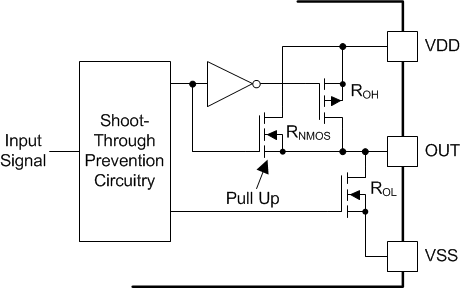JAJSG66E September 2018 – November 2024 UCC21540 , UCC21540A , UCC21541 , UCC21542
PRODUCTION DATA
- 1
- 1 特長
- 2 アプリケーション
- 3 概要
- 4 デバイス比較表
- 5 ピン構成および機能
- 6 仕様
- 7 パラメータ測定情報
- 8 詳細説明
-
9 アプリケーションと実装
- 9.1 アプリケーション情報
- 9.2 代表的なアプリケーション
- 10電源に関する推奨事項
- 11レイアウト
- 12デバイスおよびドキュメントのサポート
- 13改訂履歴
- 14メカニカル、パッケージ、および注文情報
パッケージ・オプション
デバイスごとのパッケージ図は、PDF版データシートをご参照ください。
メカニカル・データ(パッケージ|ピン)
- DWK|14
- DW|16
サーマルパッド・メカニカル・データ
- DW|16
発注情報
8.3.4 出力段
UCC2154x の出力段は、最も必要とされるとき、つまり、パワー スイッチのターンオン遷移のミラー プラトー領域の間 (パワー スイッチのドレインまたはコレクタ電圧に dV/dt が生じたとき) に最大のピーク ソース電流を供給できるプルアップ構造を採用しています。出力段のプルアップ構造は、並列接続した P チャネル MOSFET と追加のプルアップ N チャネル MOSFET を備えています。N チャネル MOSFET の役割は、ピーク ソース電流をブーストし、高速ターンオンを実現することです。出力の状態を Low から High に変更しようとする短い瞬間だけ、N チャネル MOSFET をターンオンする方法で、このような動作を実現します。UCC21540 の N チャネル MOSFET (RNMOS) のオン抵抗は約 1.47Ω であり、UCC21541 の RNMOS は約 3.2Ω です。
ROH パラメータは DC 測定値であり、P チャネル デバイスのみのオン抵抗を表します。これは、プルアップ N チャネル デバイスは DC 状態ではオフ状態に保たれ、出力が LOW から HIGH に変化する瞬間にのみターンオンするためです。このため、この短いターンオン段階の UCC2154x のプルアップ段の実効抵抗は、ROH パラメータが表す値よりもはるかに小さい値です。
UCC2154x のプルダウン構造は N チャネル MOSFET で構成されています。ROL パラメータ (これも DC 測定値です) は本デバイスのプルダウン状態のインピーダンスを表します。レール ツー レール動作では、出力電圧は VDD と VSS の間を変化します。
ゲート ドライバを確実に動作させるため、最小パルス幅に特に注意を払います。電気的特性表に示す最小パルス幅は、無負荷のドライバにおいて出力まで到達する最小入力パルスを表します。これは、ドライバ IC に内蔵されたグリッチ除去フィルタによって決定されます。出力状態の変化を保証し、貫通電流を防止するには、仕様の最大値よりも長い入力オン / オフ パルス幅が必要です。ドライバの負荷が重い場合、システムを確実に動作させるために特別の注意を払う必要があります。ゲート スイッチング中、ドライバが各遷移を完了する前に出力状態が変化すると、非ゼロ電流スイッチング イベントが発生します。レイアウトによって生じる寄生素子と相まって、非ゼロ電流スイッチングは内部レールのオーバーシュートとゲート ドライバの EOS 損傷の原因となる可能性があります。したがって、信頼性の高いシステム動作のために、最小出力パルス幅が求められます。この最小出力パルス幅は、ゲート容量、VDD 電源電圧、ゲート抵抗、PCB レイアウト起因の寄生素子など、複数の要因に依存します。確実に動作させるために必要な最小パルス幅は、電気的特性表に示されている最小パルス幅よりも大きい場合があります。各システムに必要な最小出力パルス幅を決定するには、システム レベルの検討を行う必要があります。
 図 8-2 出力段
図 8-2 出力段